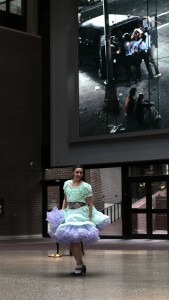The Talking Stick Festival Industry Series:
Case Study: Vancouver Art Gallery and Protocols
Introduction
In this discussion, 4 panel members discuss the issues and protocols that arise when (re)creating “Indigenous” performance art. The discussion arose from the Vancouver Art Gallery’s November 2015 Fuse event, Transform, where the art gallery space was to be “transformed” through live performance and interactions. In this event, one performance had demonstrated “bad medicine” – lack of adherence to protocols, misrepresentation and (in my opinion) borderline racist content. However, the panel stated that the focus is not on the negative but how we can learn from these experiences to better represent Indigenous art and cultures.
The panel members consisted of Open Space’s Aboriginal Curator-in-Residence France Trépanier; Grunt Gallery’s Program director Glenn Alteen; Vancouver Art Gallery’s Chief Curator and Associate Director Daina Augaitis; and Scotia Bank Dance Centre Artist-in-Residence and UBC Art History professor Dr. Miquel Dangeli. The talk was witnessed by Haida Heritage Centre’s curator Nika Collison.
Protocol and Performance art
In the discussion, the participants revisited their understanding of the performance piece, and defined their roles in the performance, if any. Some panel members had a hand in implementing the performance, with roles as Fuse organizer and Art Gallery curator. This brings me to protocols – while there are no set rules that all First Nations/ Metis/Inuit peoples can use to guide their performance work, there are Indigenous concepts that can help one to meet protocol.
The Four Rs: Respect, Relevance, Reciprocity, Responsibility. The 4 Rs are often used to conceptualize Indigenous pedagogy for Western educational systems. When looking at the Angela Brown performance at the Vancouver Art Gallery, one can easily check protocols by using the 4 Rs: does it respect Haida dance/culture/art? What is it’s relevance to the Haida culture/Indigenous culture/dance? Is this a one-sided relationship or is anything reciprocated? And is this performance being responsible for its use of Indigenous/non-Indigenous actors/performers? These questions are meant to shed light on the power inequalities that can create imbalanced and damaging relationships. Francis Trépanier asked that we use a 5th R: Reverence – that is, the meditative and spiritual feeling of awe.
Another concept explored was “re-enactment” in performance. The performance was cited by the choreographer Angela Brown as being a “re-enactment” of a 1970s performance on Haida Gwaii by performer Evelyn Roth and artist Robert Davidson. Artist Robert Davidson was present at the discussion, and stated that he had never given permission nor did he know about this “re-enactment” performance. The concept of a “re-enactment” was questioned, as the original performance did not resemble the Fuse performance.
Protocol in the Art Gallery
The bigger issue that emerged from the discussion was the importance of having Indigenous perspectives in Institutional spaces that represent Indigenous peoples and cultures. The issue of responsibility means that institutions such as art galleries, museums and schools need to address the underrepresentation of Indigenous people, particularly in higher levels of planning and curating. The Vancouver Art Gallery is planning the construction of a new gallery space, with a dedicated space to Northwest Coast First Nations Art, so there is huge potential for collaboration and community-building. The underrepresentation of Indigenous perspectives needs to start with community – we need to look at the “art community” as it exists and find ways to include diversity. The location of the Vancouver Art Gallery on Coast Salish land – Musqueam, Tsleil-Waututh and Squamish Nations – gives many opportunities to “reconcile”, collaborate and educate.
Witnessing
To conclude the discussion, Haida Heritage Centre Curator Nika Collison shared her notes from what she witnessed. Nika noted all the problems that arose from the discussion : misrepresentation, re-enactment, permission, underrepresentation. After which, she notes all of the positive concepts: the 5 Rs; collaboration, future goals, creating new communities. This discussion reveals the ways in which we can learn from mistakes and look forward to creating a positive and more inclusive future.
Witnessing this discussion reminded me of my own responsibilities as an Indigenous artist. When I create an artwork, I am representing not only myself but also my family, clan, community, ancestors and Nation. It would be nice to hear from the choreographer to see what her side of the story is, or to allow her the room to acknowledge her actions.
Works Cited
Vancouver Art Gallery FUSE: Transform


